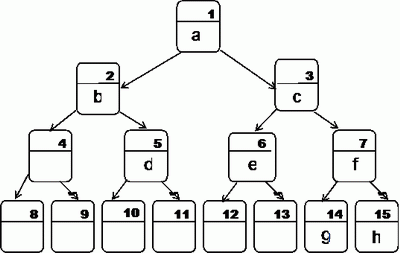Trees - alexdaube/My-Software-Engineering-Guide GitHub Wiki
Trees
What?
- An oriented acyclic and weakly connected graph that starts with a root and only has one path to reach another node
- Recursive Definition => A tree is a root node pointing to trees, which themselves point to other trees
- Each node contains unique information

Terminology
- Parent => Node Immediately predecessor of another
- Child => Node Immediately successor of another
- Root => Node that has no parent
- Leaf => Node that has no child
- Ancestor(s) => All nodes that are predecessors to a node up to the root
- Descendant(s) => All nodes that are successors to a node up to its accessible leafs
- Height of a node => Length of longest path to reach a leaf from a node
- Height of the tree => Height of the root node
- Node depth => Length of a path from the root to the node
- Node degree => Number of children a node has
- Sub-tree => Tree composed from a bigger tree...
Types
- Degenerate tree => A simply linked list is a tree of degree 1
- Binary Tree => Of degree 2
- Binary Search Tree => All keys must be different at all time. The left sub-tree of a node must contain strictly lower values and the right sub-tree of a node must contain strictly higher values

- Self Balancing Binary Search Tree(AVL) => For each node, the difference between height of the its right sub-tree and its left sub-tree is equal or less than 1. Searching in O(Logn)
- N-ary tree => A tree of degree N
Tree Traversal
- Pre-order => Priority is to the parent. Children comes after.
- Post-order => Priority to the children. Parent(root) comes after
- In-order(symmetric) => Left child, root, right child... Gives us elements in order from smallest to biggest
Expression Tree
- Leafs are operands(variables or constants) and internal nodes are operators. A calculation can be reconnected with In-order traversal
Implementations
- 2 major implementations => In a table and by chaining
Binary Tree Table
-
Index starts at 1 with the root
-
Contains up to 2^h nodes
-
Advantages =>
- Simple to visit children
- No memory to store pointers
- Memory to insert a node is already available
-
Disadvantage =>
- Memory wasted for holes
- Re-allocation is higher if node is outside the boundaries of the existing table

-
Tree is a heap =>
- When Binary Tree is complete except maybe the last level where the missing nodes are to the right.
- Node value is always bigger than or equal to the value of its children(Max Heap) see Heap for prioritize implementation
Binary Search Tree
- Use to implement dictionaries => Efficient for Insertions, Suppressions, Finding
- Keep elements in order with symmetric traversal
- The 3 basic operations have a complexity of O(logN)
By Chaining
-
Keeps a pointer of both children
-
Advantages =>
- Size of the tree is dynamic
- Easy to operate on pointers
-
Disadvantage =>
- Keep an eye on double references and memory leaks
- Tree traversal goes from root to leafs only. Can go the other way with recursion
-
With AVL, equilibrium must be maintained... It must be rebalanced if it ain't so
-
AVL complexities =>
- Leaf insertion => O(1)
- Balancing verification => O(1)
- Update height of a node => O(1)
- Balancing(zigZag) => O(1)
- Find insertion point => O(log n)
- Be at the critical node for balancing => O(log n)
- Node insertion => O(log n)
- Node Removing => O(log n)
- Finding Node => O(log n)